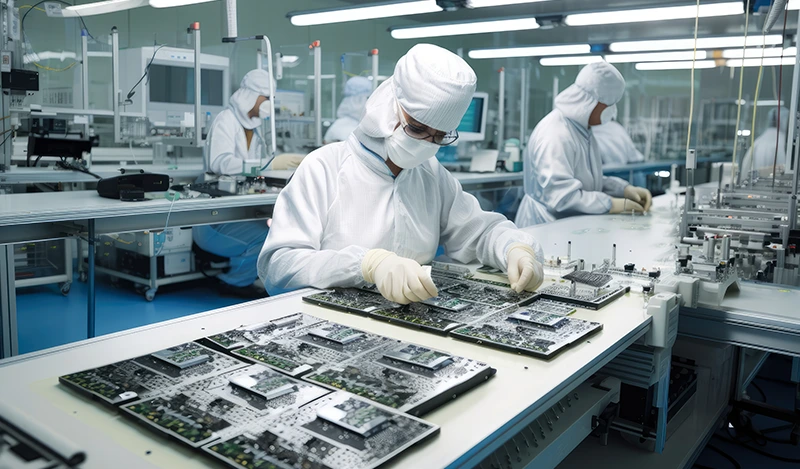BEIJING — China is intensifying efforts to protect its technology industry from the growing impact of US chip restrictions, as the country faces worsening shortages of advanced semiconductors vital for artificial intelligence and high performance computing.
According to people familiar with the matter, Beijing has started directing how the output of Semiconductor Manufacturing International Corp. (SMIC), the country’s largest contract chip maker, is distributed.
The intervention aims to prioritize national tech champion Huawei Technologies, which relies on SMIC for the production of artificial intelligence chips.
The move highlights the strain on China’s semiconductor sector as Washington’s export controls increasingly restrict access to cutting edge chipmaking equipment and advanced processors used in AI development and cloud computing.
The United States has tightened semiconductor export restrictions in recent years to prevent China from acquiring technology that could enhance its military or surveillance capabilities.
The Biden administration’s latest rules, announced in October 2023, further limited China’s access to advanced GPUs, lithography tools, and chip design software.
These restrictions have forced Chinese firms to seek domestic alternatives, accelerating Beijing’s push for technological self sufficiency. SMIC, Huawei, and other firms are central to this national strategy, but their efforts face significant technological hurdles.
“China’s semiconductor ecosystem remains years behind global leaders like TSMC and Samsung when it comes to high end chip manufacturing,” said Daniel Wu, a semiconductor analyst at the Shanghai based consultancy TechView Partners. “Beijing’s intervention in SMIC shows how critical chip supply has become for its strategic industries.”
Experts say the prioritization of Huawei reflects both political and practical realities. Huawei has emerged as a key player in China’s artificial intelligence drive, especially after it unveiled its Ascend series of AI chips and the HarmonyOS ecosystem, which aim to reduce reliance on U.S. technology.
“By supporting Huawei, Beijing is trying to maintain momentum in sectors where it can still compete AI, telecommunications, and industrial automation,” said Li Qiang, a technology policy researcher at Renmin University.
But this comes at the cost of other firms, many of which are now struggling to secure enough chip supply for production.
SMIC, which manufactures chips using older lithography technologies, has been unable to scale up production of advanced 7 nanometer and 5 nanometer chips due to US restrictions on critical Dutch and Japanese equipment.
Analysts estimate that SMIC’s 7 nm chips have yields far below international standards, limiting their commercial viability.
“The US curbs are doing exactly what they were intended to do slowing China’s progress in next generation semiconductors,” said an industry official in Hong Kong, speaking on condition of anonymity due to the sensitivity of the issue.
Data from research firm IC Insights shows that China imported roughly $350 billion worth of semiconductors in 2024, down nearly 15 percent from the previous year as domestic production partially offset foreign supply. Yet advanced chips those smaller than 10 nanometers account for less than 2 percent of China’s total output.
By comparison, Taiwan’s TSMC produces nearly 60 percent of the world’s advanced chips, while South Korea’s Samsung Electronics holds around 20 percent. The gap underscores the scale of China’s challenge in catching up amid ongoing restrictions.
Huawei’s reemergence in the smartphone market with its Mate 60 series, powered by a domestically produced 7 nm chip, showcased progress but also raised questions about long term sustainability.
Analysts believe SMIC had to allocate significant production capacity to fulfill Huawei’s chip orders, prompting Beijing’s recent coordination efforts.
In Shenzhen, China’s technology hub, smaller hardware manufacturers report growing difficulties in accessing even mid range chips.
“We used to get our processors within weeks, now it can take months,” said Jason Liu, who runs a robotics startup in the Nanshan district. “Prices have gone up by at least 30 percent since last year, and there’s little visibility on future supply.”
Some domestic chipmakers have shifted focus to less advanced, high volume products for industrial use, while others are seeking partnerships in Southeast Asia to bypass certain restrictions.
“The industry is under stress,” said a manager at a Suzhou based chip design firm, who requested anonymity. “Everyone is waiting to see how far the government will go in managing allocation and whether smaller players will be left behind.”
China’s long term strategy remains focused on technological independence. The government has pledged hundreds of billions of yuan in subsidies and funding through its “Big Fund” to accelerate domestic chip research, manufacturing, and talent development.
Analysts expect Beijing’s involvement in semiconductor allocation to deepen as pressure mounts from Washington’s allies. Japan and the Netherlands have aligned with US restrictions, cutting off critical supplies of lithography machines and materials.
“The race for semiconductor leadership is no longer just about business it’s a matter of national security,” said Chris Tang, a professor of global supply chains at UCLA Anderson School of Management. “China will likely double down on indigenous innovation, but progress will take time.”
Industry watchers predict that China may reach parity in certain chip categories, such as 14 nm logic and memory chips, within three to five years. However, catching up in AI grade processors and leading edge lithography could take a decade or more.
As Washington tightens its semiconductor controls, Beijing’s response underscores the high stakes of the global chip rivalry.
By steering scarce resources toward strategic companies like Huawei, China is signaling its determination to keep pace in key technologies, even at the expense of market efficiency.
For now, America’s chip restrictions are biting hard and China’s path to self reliance remains steep, costly, and uncertain.

